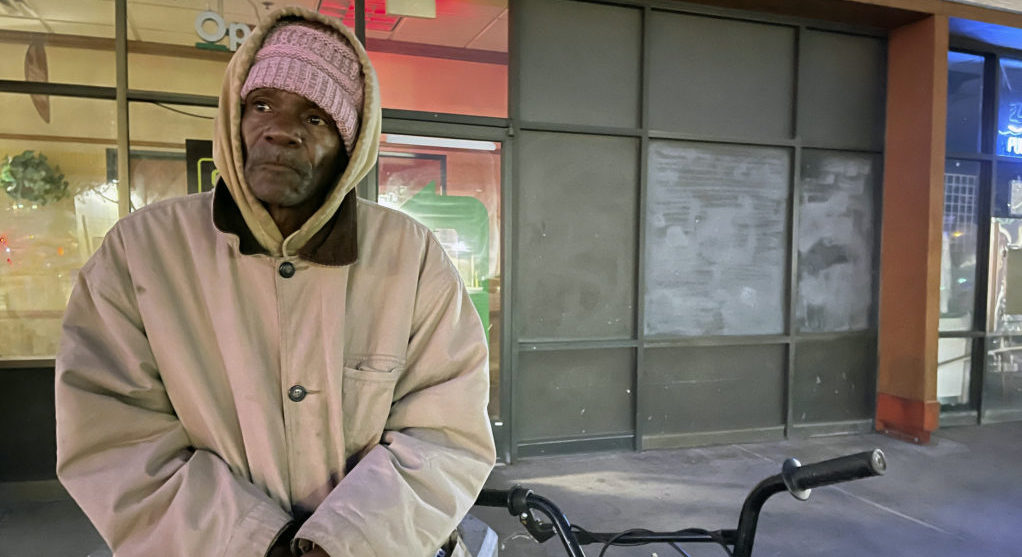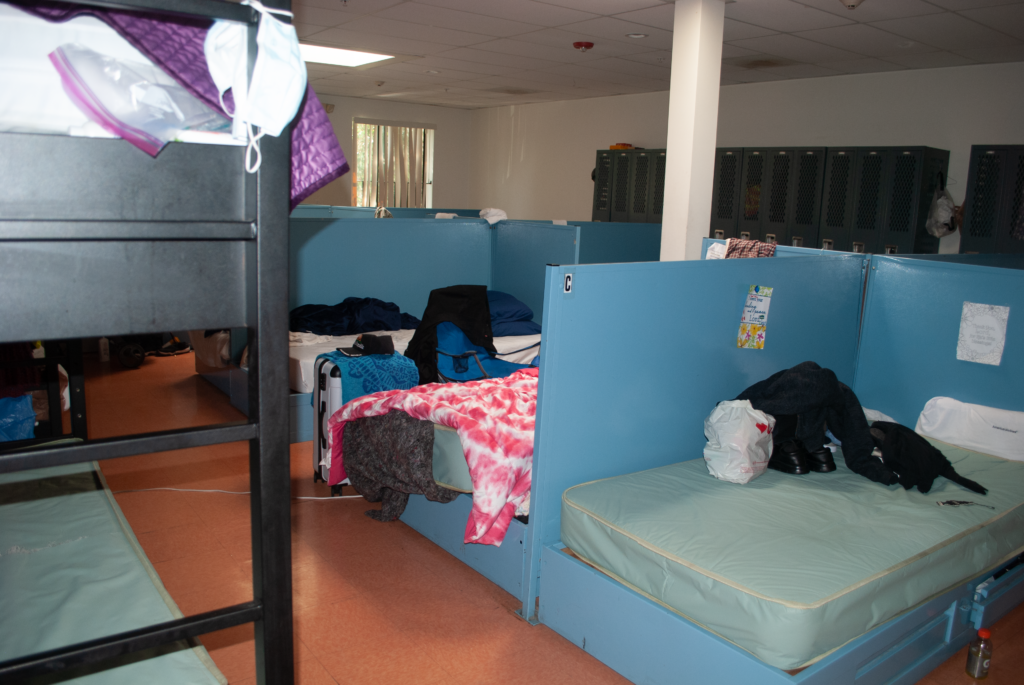Unhoused and Disabled in America
For the chronically ill and people with disabilities, life on the streets and in shelters presents a unique set of challenges. Michael Warner, 61, who says he has been living on the streets for three years, talks about his situation during a one-day count of homeless individuals in Phoenix on Jan. 25, 2022. Photo: Anita Snow/ AP
Michael Warner, 61, who says he has been living on the streets for three years, talks about his situation during a one-day count of homeless individuals in Phoenix on Jan. 25, 2022. Photo: Anita Snow/ AP
Alfonso Rodriguez was a successful 45-year-old entrepreneur when he was diagnosed with pancreatic cancer in 2007. His weight quickly dropped from 250 to 97 pounds, but that was only the beginning of his troubles. Unable to work, and burdened by the cost of his treatments, Rodriguez’s car dealership in Compton, California, began to fail, as did its adjoining accessory store and mechanic’s garage. When his cancer went into remission in 2019, he was homeless and began to drink heavily. He now lives at Ascencia, a temporary shelter in an industrial neighborhood in Glendale.
Like many small business owners, Rodriguez was the centrifugal force pulling it all together himself. As a single man, he had no family to fall back on. Due to the physical toll and time lost to his radiation treatments, he wasn’t as capable nor as available to keep these businesses afloat. On top of that, he had been paying the $6,000 monthly rent for these spaces, so he wasn’t prepared to pay for costly radiation treatments. After he lost his home and businesses, his only transportation was a bicycle, a harsh reality for someone who has made a living in the car business.
“I don’t look back,” said Rodriguez, who has had a year of recovery from substance abuse. “This is the first time I got help from somebody else.”
The mere fact that there are over four times more physically disabled people on the streets than in shelters suggests that people get sicker without regular meals, shelter, medical attention, and safety.
Rodriguez’s story is not unique. Even with the Affordable Care Act (ACA), an illness can take away a job, then health insurance, a home, a car and sometimes, a family. In 2019, the California Policy Lab published results of a national study on homelessness in which they found that roughly 553,000 Americans were unhoused, 46% of whom had physical disabilities while living on the streets, and only 11% of whom were in shelters, or staying with friends and family. All 57% reported that their disabilities contributed to their homelessness. The mere fact that there are over four times more physically disabled people on the streets than in shelters suggests that people get sicker without regular meals, shelter, medical attention, and safety.
The report also showed that 50% of physically disabled unhoused individuals experienced “trimorbidity,” a triple threat that includes substance abuse and mental illness to having a physical health condition. The stress of having to consider one’s survival on a constant basis while fighting hunger, discomfort and potential assault could woo even the most resilient into mental decline and a need to self-medicate.
But did the help come too late? Due to the closer medical attention he’s receiving, Rodriguez found out two weeks ago that his cancer is back. He’s now undergoing more treatments. By day Rodriguez appears an easygoing, affable man; by night he cries in his sleep because of pain from the spinal cord injury combined with chemotherapy. He said he feels guilty about causing a disturbance on the men’s side of the shelter where about 20 other men are sleeping, but his pain is excruciating. It’s not unusual for pain to escalate while lying still without distraction.
What Rodriguez is coping with is every person’s fear in a shelter. “What if I lose my spot?” To be able to stay in the shelter one must demonstrate the ability to handle their own personal care. This is a conundrum for people with physical disabilities. To get in, one must be fragile enough to score high on what is known as the Vulnerability Index — Service Prioritization Decision Assistance Prescreen Tool (VI-SPDAPT), but being too disabled may disqualify someone and send a person to assisted living. Added to that are the abandonments experienced by people with physical disabilities. Most stories about disability emphasize that families keep their dependent relatives safe, but many families abandon disabled relatives. They may have their own disabilities; they may have a poor history with the disabled member, or they may simply discriminate.
By day Rodriguez appears an easygoing, affable man; by night he cries in his sleep because of pain from the spinal cord injury combined with chemotherapy.
One pathway to a shelter begins when outreach workers visit encampments around the city to locate the most vulnerable people: families with children, adults who are elderly, people with severe disabilities or young adults who have aged out of foster care. It’s a challenge to find those with physical disabilities that are not immediately obvious, such as diabetes, heart conditions, epilepsy and other conditions. These sensitive questions might damage an outreach worker’s rapport with people in an encampment, but they are a necessary piece in solving a housing crisis in a country with a healthcare crisis; the two crises are not mutually exclusive.
Another common pathway into a shelter is a referral through one of the nearby emergency rooms. Jennifer O’Reilly Jones, a program coordinator in Pasadena, pointed to the ACA, which allows for more people to be enrolled. “The ACÁ has been a game changer,” said O’Reilly Jones. This prevents people from using costly emergency rooms — the only option for those without insurance. O’Reilly Jones said that the primary objective is housing and that healthcare enrollment often comes later. The system is motivated to enroll people because of the cost of emergency rooms, but many people still have no health insurance.
In Los Angeles County, the agencies serving homeless people divide the population into three categories to serve separate needs: adults, families with children and transitional-aged youth. Ascencia only serves adults and families with children; at midday most of the residents at home were elderly. Younger residents go out to school or to jobs, but there are thousands of elders who are destitute, and elders are more likely to have disabilities. The California Policy Lab reported that 41% of California’s population of homeless people is over the age of 55. That amounts to tens of thousands of older folks since there are now roughly 69,000 homeless in Los Angeles, according to the 2022 count taken by Los Angeles Housing Services Authority.
O’Reilly Jones attributed a short-term slowdown in homelessness rates to funding from Measure H, a bill that voters passed to increase resources for the housing crisis, though Dr. Laura Duncan, Ascencia’s executive director, was less optimistic about the value of Measure H funding. This discrepancy is perhaps due to their different vantage points: A program coordinator’s lens is that of an administrator, but Duncan is in the trenches running a shelter and multiple ancillary services. The administrative branch has a better overview of the problem, but less awareness of the flaws in the system. People on the ground like Duncan have to steer people through that flawed system. For example, she described a dumbfounding situation for parents with small children: they can’t have both food stamps and daycare services. It’s good that they receive food stamps, said Duncan, “but how is a mom going to support her family if she has no daycare?”
Tying health insurance to employment has been devastating to people with disabilities on a low budget and since this group has a lower income than most, it can be life-threatening.
For those working in social services it often appears that the system is set up to keep people in poverty instead of pulling them out of it. For disabled people, this is apparent in how the social security disability system is set up. Recipients of disability payments are living well below the poverty level, but the maximum amount they may earn to supplement their income is $1,350 a month, which still keeps a person well below the poverty level. If they earn more, they lose their benefits, and for people with physical disabilities, that’s tantamount to losing a lifeline. Many cannot risk full-time jobs because of the potential of losing their job if they are fired or laid off, or they cannot physically withstand the work. And if they lose that job, they lose their health insurance.
Why are Americans with disabilities threatened with poverty?
According to the Annual Disability Statistics Compendium, disabled Americans in 2019 earned 15% less than their able-bodied counterparts. The median income for disabled people was $39,297. Statista reported a gap of 17% in 2020. Unemployment for population of disabled people as a whole was more than twice the rate of their nondisabled peers in 2018 while the economy was booming. This is how so many disabled people become homeless.
For disabled Americans, there is already a huge disadvantage in terms of income and therefore no parachute when they lose a job. Tying health insurance to employment has been devastating to people with disabilities on a low budget and since this group has a lower income than most, it can be life-threatening.
“If people end up here, they don’t have any resources,” said Duncan.
* * *
Daniel Axinte, 60, was working for Amazon in England when his diabetes caused complications in his legs resulting in amputations — one above the knee and one below the knee. He couldn’t perform his job, so he moved back to Los Angeles, where he lived from 1984 to 2010. Curiously, Axinte recalls exact dates for major turning points in his life, repeating several times that he came home to Los Angeles on January 14 of this year and was on the streets by March. He came home and realized that he had no job, no health insurance and no more access to the United Kingdom’s National Health Service.

People with diabetes may lose a limb and/or eyesight because they can’t afford costly medical supplies. Duncan sees this often in the population of people who are homeless. Diabetes is more common among older people and the poorest racial groups — both groups make up a majority of unsheltered Americans.
Axinte has lived most of his life in L.A., always finding his way into jobs that provided stability before he lost his legs. Now, he is eager for a meeting with social services to be enrolled in a health plan. Since he has no money, no insurance and no family support, Axinte scrambles to find $230 a month for his insulin supplies. If he had insurance, he might be a candidate for prosthetic legs, which would give him more access to jobs. Born in Romania, Axinte speaks six languages: Romanian, German, French, Italian, Spanish and Serbian (which he refers to as Yugoslavian). He has four children, each in a different country. None of them call or visit. He had hoped to be reunited with his daughter who lives here, but he said her mother is advising against that, which he thinks is because of his legs.
“Pretty much for the last nine months I’m abandoned,” he said. He is quick to point out that he has never had an addiction problem. “I do everything myself.” Before admission to Ascencia, he had to prove that he could independently perform his own personal care.
Now that Rodriguez and Axinte are in a shelter, they have a fighting chance at survival. To get a sense of shelter life, Camille Guerrero, fundraiser and administrator at Ascencia, provided a tour.
Ascencia is on a street with industrial warehouses and aside from the residents milling about, one in a wheelchair, it is easy to miss. A pleasant caseworker in the lobby greeted guests from behind a plastic screen — a common sight during the pandemic. The center is sparsely furnished with plastic chairs and tables, the mostly bare walls painted a drab beige.
Guerrero was pleased to show off a kitchen that was spotless and organized, including a pantry stocked with non-perishables, enough to feed the 45 residents plus clients from the streets who receive help. Volunteers come in as guest chefs and they serve meals as casual as a pizza delivery or as nuanced as a curried chicken dinner. Guest chefs often fund the meals they serve. There’s a dining area and three workstations for people seeking jobs. For the children, there is one hour a week of art therapy conducted on Zoom in the conference room. Stairs and an elevator lead up to the two sleep areas separated by a wall that designates each side as male or female. The beds themselves are separated only by dividers that run a few feet higher than each bed. There is a bathroom on each side of the sleeping quarters, and about 22 beds on both sides. Some were made while others were stripped for people who had recently moved on.
Now that Rodriguez and Axinte are in a shelter, they have a fighting chance at survival.
It is difficult to imagine how anyone could sleep restfully in such a crowded space — especially while in pain. It is difficult to imagine how anyone could sleep restfully in such a crowded space — especially someone with the level of physical pain described by Rodriguez.
The bathrooms are similar to many public bathrooms with toilets and shower stalls. It seemed challenging to navigate for someone without legs or in a wheelchair, but not impossible. (Most public bathrooms and showers are challenging for people who are not the standard height because the faucets are set for people over five feet tall.)
After the tour, we met with Duncan, who has a degree in psychology and has been working with disabled clients and other vulnerable populations for years. She said she got interested in this work when she was growing up because there was a girl in her neighborhood who was segregated from the other children because of a disability. Duncan met us at a table in her office near a Van Gogh print, the one with a vase of sunflowers. It brought out something of her essence, her curly halo of reddish hair matching the inner circle of flowers, symbolic of the growth and blossoming under her care.

Every worker at Ascencia is also a fundraiser. The need to solicit resources is constant. In addition to money, they collect household items to give to the residents in permanent housing.
There is a feeling of camaraderie among the occupants and the staff. Residents seemed more empowered at the shelter than the unsheltered homeless people because the latter group is forced to continuously focus on basic needs: food, water, shelter and physical safety. At Ascencia, people experience generosity, however small. In this transitional space, they are all just passing through. Residents each spend up to six months there, but they arrive and depart at different points in time.
People who have had to be extremely self-sufficient are still allowed that independence, but they get to enjoy some care and a sense of family, too. The staff is highly committed.
After a standard six-month stay, most residents are placed in permanent housing. Ascencia boasts a 95% success rate among past residents in maintaining their housing, which Guerrero attributed to “wraparound care,” such as food stamps, social security disability, healthcare and social service workers — all things necessary to keep people in their homes and able to work.
Hopefully, Rodriguez and Axinte will be placed in permanent housing. These two men are now on the luckier side of the statistics. In a city of 69,000 unhoused people, half of whom may have their own physical disabilities, they are two of the 45 people accepted into Ascencia — two people with a fighting chance at regaining stability.
Your support matters…Independent journalism is under threat and overshadowed by heavily funded mainstream media.
You can help level the playing field. Become a member.
Your tax-deductible contribution keeps us digging beneath the headlines to give you thought-provoking, investigative reporting and analysis that unearths what's really happening- without compromise.
Give today to support our courageous, independent journalists.






Thank you for a sensitive, thoughtful article on the (almost) invisible people of America. The fact that parents can't get food stamps and childcare assistance at the same time is beyond cruel. I couldn't verify that online, could you please post a reference? Thanks again, Nevin Oliphant